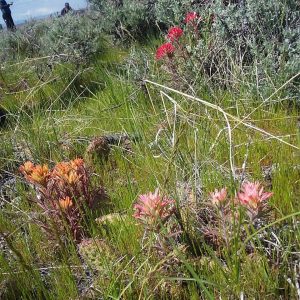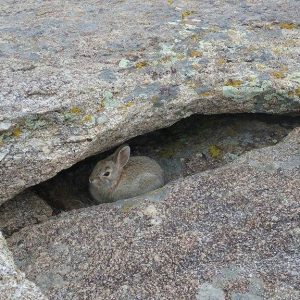Montrose, Colorado is a perfectly sized town of about 20K people. It sits as a central location to everything a lover of the West covets. The San Juans tower in the south, the Cimmarons to the east, and Black Canyon to the northeast. The northern horizon holds the Gunnison Gorge and the Grand Mesa. To the west, Paradox Valley, Escalante/Dominguez Canyon, and the Manti La Sals just before you get to Moab. I’m overwhelmed and overjoyed.
The high deserts and red rocks in Escalante/Dominquez canyon are reminiscent of the Grand Staircase in Utah, one of my favorite places back home. We spend a lot of time here, returning to monitoring sites of the Hookless Cactus, Sclerocactus glaucus and hunting for new populations. I have developed a keen eye for cacti, to say the least.
Escalante canyon is riddled with seeps of perennial water flows that feed through cracks in the sandstone, creating habitat for several rare, “hanging garden” species such as Eastwood’s Monkeyflower, Mimulus eastwoodiae and the Giant Hellborine orchid, Epipactus gigantea. The misty seeps are protected from the sun year-round and will undoubtedly bring my dog and I relief in the foreboding hot months ahead.
I was lucky enough to be invited down the Dolores River for a 3-day trip with the Rangers here in Montrose as the team botanist. I was equipped with a map through the application Avenza on my phone, by which I was able to find various populations of rare and narrowly endemic species that occur along this unique river. Among the species included the Naturita Milkvetch, Astragalus naturitensis, and 3 hanging garden species (including the aforementioned) in addition to the one and only Kachina Daisy, Erigeron kachinensis. It was kind of dreamy to see all three of these in the same square meter.






Most of my time has been spent in sage grouse country above Crawford, on the north rim of the Black Canyon. The Gunnison Sage Grouse, Centrocercus minimus is a federally protected species. I have camped out on two lek counts and have had the pleasure of observing the birds dancing and popping on the ridge at dawn. Soon we will be running transects in this habitat to monitor the vegetation. Most of our work has been done in saltbush/greasewood shrublands, so this will be a change of pace.
I’ve also spent a lot of time in Crawford on corvid surveys. They consist of walking or mountain biking along the 7 mile stretch of road that overlooks the West Elk mountain range. I stop every 400 meters for 10 minutes, walk around with binoculars, and try to flush some scrub or pinyon jays out of the canopies so I can count them. Last week I counted over 100 ravens. The biologists at the BLM suspect that these intelligent birds may have a detrimental effect on the sensitive sage grouse population.
There is some curiosity about the Peregrine Falcon in the Uncompahgre Field Office, and I’ve had the opportunity to take part in a one-night raptor survey in Paradox Valley. I woke up at 5 am with a scope and walked around Pinyon/Juniper forests, scanning the massive cliff walls. It’s a good thing that I marked my camp on the GPS because it is SO easy to get lost out there.

While in Paradox, we surveyed an extremely isolated population of the Sandstone Milkvetch, Astragalus sesquiflorus. You’ve never seen something so cute in your life. My partner and I were able to find the boundaries of the po pulation after a long days work, and later mapped it out in ArcMap. It is so rewarding and interesting to see exactly where it is on a map after being there all day. I’m really excited to learn more about GIS. Now that I’ve received my access card, here in my SIXTH week, I can start working with our wonderful GIS wizard at the BLM.
pulation after a long days work, and later mapped it out in ArcMap. It is so rewarding and interesting to see exactly where it is on a map after being there all day. I’m really excited to learn more about GIS. Now that I’ve received my access card, here in my SIXTH week, I can start working with our wonderful GIS wizard at the BLM.
I spend my spare time reading about Colorado’s flora, learning about birds, keying out and drawing plants, learning to love grasses (begrudgingly), and hiking my dog to a new beautiful place every weekend. I left my undergrad with a good base in botany, but with a thirst for field experience, mostly a wanting to see how plants interact with their environment. Here I am! I have a lot to learn, but this is the kind of work that just keeps giving, and I remember why I chose a major in biology.

See you in Chicago!
M
















 pulation after a long days work, and later mapped it out in ArcMap. It is so rewarding and interesting to see exactly where it is on a map after being there all day. I’m really excited to learn more about GIS. Now that I’ve received my access card, here in my SIXTH week, I can start working with our wonderful GIS wizard at the BLM.
pulation after a long days work, and later mapped it out in ArcMap. It is so rewarding and interesting to see exactly where it is on a map after being there all day. I’m really excited to learn more about GIS. Now that I’ve received my access card, here in my SIXTH week, I can start working with our wonderful GIS wizard at the BLM.




















